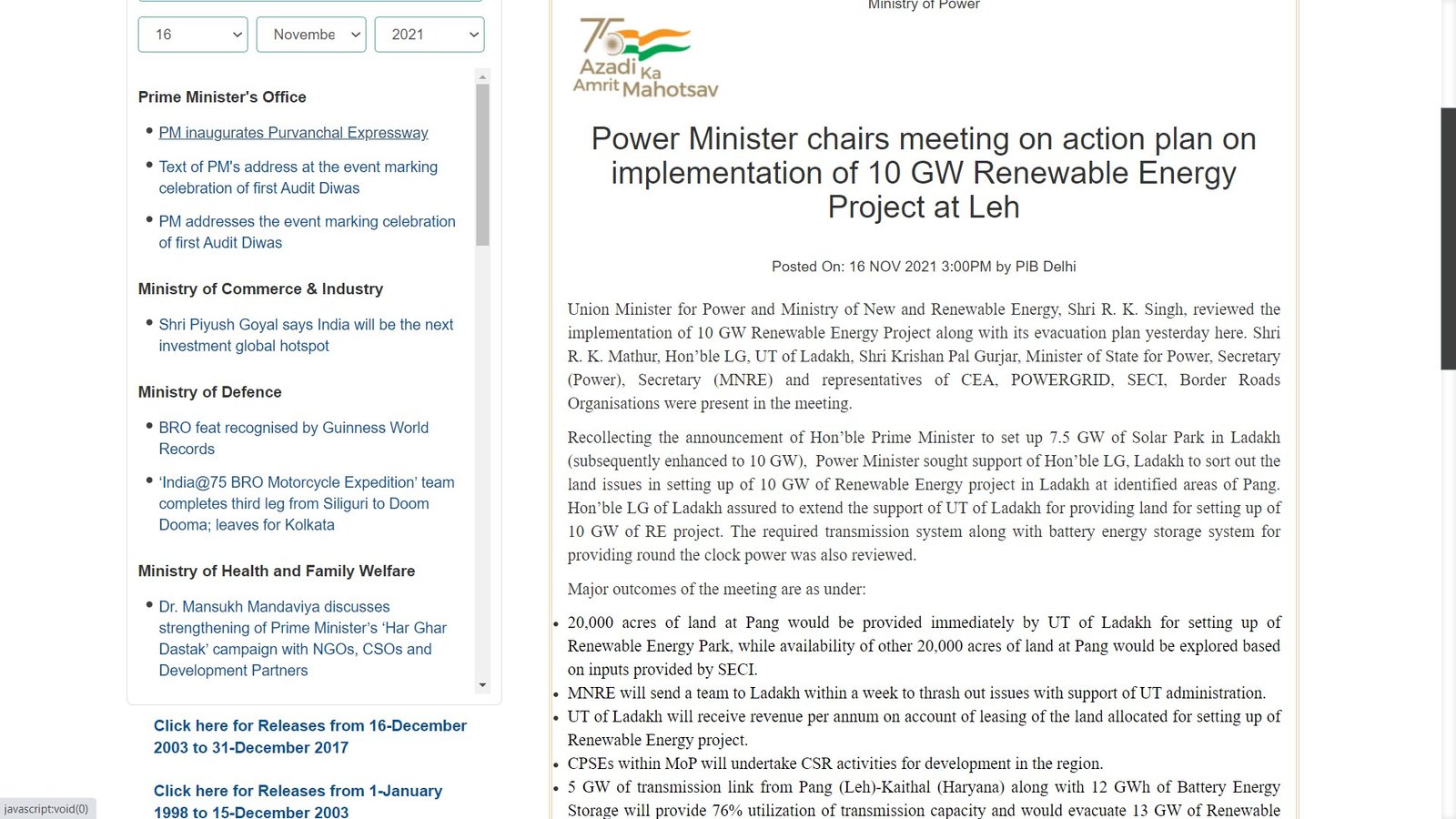
Prepare IAS Coaching
Current Affairs

Title : RENEWABLE ENERGY SECTOR IN INDIA
Date : Nov 17, 2021
Description :
Based on an News Article published in the ‘The Press Information Bureau’ on 16th November 2021
Useful for UPSC CSE Prelims and Mains (GS Paper III)
About the Renewable Energy Sector:
- Last year, the Prime Minister of India has announced about having huge renewable energy deployment plans for India for the next decade which are likely to generate business prospects of around $20 billion per year.
- Post the inauguration of the 3rd Global Renewable Energy Investment Meeting and Expo (RE-Invest 2020), the PM addressed and invited the investors, developers and businesses to join India's renewable energy journey.
- After the success of Performance Linked Incentives (PLI) in electronics manufacturing, the government has decided to give similar incentives to high efficiency solar modules.
About the Renewable Energy Sector:
- Dedicated Project Development Cells have been established to facilitate investors ensuring 'Ease of Doing Business'.
- India's renewable power capacity is the fourth largest in the world and is growing at the fastest speed among all major countries.
- India is a big market and a lot of countries are attracted towards it in terms of One Sun, One World, One Grid and International Solar Alliance.
- The renewable energy capacity in India is currently 136 Giga Watts, which is about 36% of its total capacity.
About the Renewable Energy Sector:
- Target for capacity increase is 450GW by 2030, increasing 25GW every year as we move forward.
- Per capita consumption of energy in India is quite low as compared globally.
- Power sector, being primarily dependent on fossil fuels, is one of prime sources of air pollution.
Why Renewable Energy:
- Sustainable: Energy generated from renewable sources will be cleaner and greener and more sustainable.
- Employment opportunities: Inclusion of a newer technology simply means more employment opportunities for the working population of the country.
- Market assurance: From the economy point of view, renewable sources provide the market and revenue assurance which no other resources can provide.
- Power supply: Providing 24*7 power supply to 100% of the households, sustainable form of transports are some of the goals that can only be achieved through sustainable power that comes from renewables.
Initiatives Taken in India:
- PLI Scheme: The Production Linked Incentive Scheme (PLI) scheme is an excellent initiative of the Government of India with respect to enhancing the manufacturing sector.
- The scheme proposes a financial incentive to boost domestic manufacturing and attract large investments in the electronics value chain including electronic components and semiconductor packaging.
- Pradhan Mantri- Kisan Urja Suraksha evam Utthaan Mahabhiyan: PM- KUSUM aims to provide financial and water security to farmers through harnessing solar energy capacities of 25,750 MW by 2022.
- Solarisation of water pumps is a step in distributed power providing at the doorstep of the consumer.
- The Ministry of New and Renewable Energy on its website also hosts Akshay Urja Portal and India Renewable Idea Exchange (IRIX) Portal.
- IRIX is a platform that promotes the exchange of ideas among energy conscious Indians and the Global community.
India’s Key Focus for Next Five Years:
- The Twin Challenge: India has a twin challenge of providing more energy as well as cleaner energy to the masses in India.
- It should focus on getting into the manufacturing of the solar panels under the Atma Nirbhar Bharat initiative as the demand is to create jobs as well as supply decentralised energy to all the households in India.
- Look and develop the entire supply chain of all the components beside the manufacturing sector.
- Methanol and Biomass: Looking for other alternatives such as methanol based economy and biomass.
Bio-CNG vehicles with 20% blending in petrol is also a target the government has been chasing.
- Conversion of energy from Biomass is a considerable option as it will clean the cities as well as reduce our energy dependence.
- Fuels produced from biomass have a high calorific value and are cleaner than traditional biomass.
- Hydrogen based FCV: Hydrogen in technology is likely to change the landscape of renewables, shifting towards Hydrogen Based Fuel Cells Vehicles (FCV) is another area of focus.
- Grid Integration: It is the practice of developing efficient ways to deliver variable renewable energy (RE) to the grid.
- Identifying the demands which are in tune with the characteristics of the renewables, focussing on characteristics of renewables mainly solar and wind and considering their variability as strength rather than weakness.
Challenges with Renewable Energy:
- Integration with the Main Grid: Integrating the renewables with the main grid is the area India needs to work upon.
- To accelerate the uptake of renewables, storage and battery solutions is needed in large quantities.
- Cost factor: Renewable resources are slightly more expensive than conventional sources.
- 24*7 Power Supply: Sustainable, round-the-clock power supply along with the storage system is a big challenge ahead.
- Agricultural Sector: Much power is consumed in the agricultural sector.
- The challenge is to provide sufficient power and energy to every household and to the agricultural sector as well.
Way Forward:
- Identification of areas: Renewable resources specially wind cannot be set up everywhere, they require specific location.
- Identification of these specific locations, integrating them with the main grid and distribution of powers; A combination of these three is what will take India forward.
- Exploration: More storage solutions need to be explored.
- Agriculture subsidy: Agricultural subsidy should be rectified in order to ensure that only the required amount of energy is consumed.
- Hydrogen fuel cell based vehicles and Electric vehicles: These are the most suitable options when it comes to shifting towards renewable sources of energy, that’s where we need to work upon.
Conclusion:
- A well planned road map is needed, for which NITI Aayog is coming up with Energy Vision 2035 to achieve India's clean energy goals.
- Diversified energy mix is what India needs to focus on, no doubt solar and wind have a lot of potential, Hydrogen would be a game changer in Indian energy transition space.
- Renewable sources of energy are expected to replace fossil fuels by 2050.
- India should be working on areas like investment in infrastructure, capacity building and better integration in the near and immediate future.
